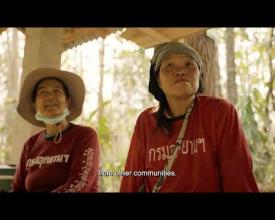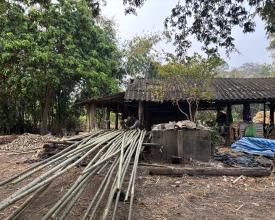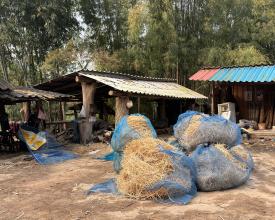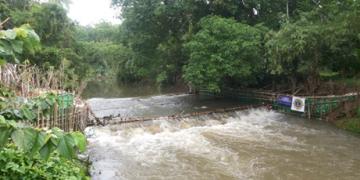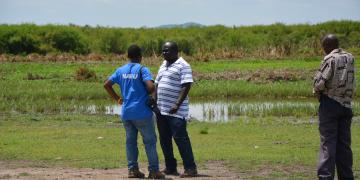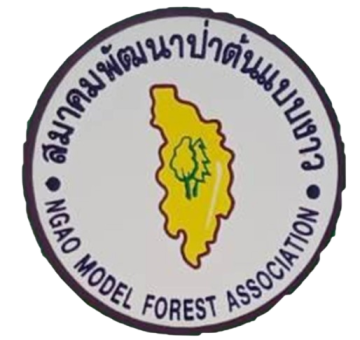
Sustainable farming that benefits people and nature in Thailand
Ngao Model Forest, located 250 kilometers from Thailand’s second-largest city, spans 175,159 hectares. Established in 1964 to address social, economic, and environmental challenges, it joined the International Model Forest Network in 2000. The community's shift towards sustainable practices has preserved over 60% of forest cover and diversified economies with bamboo businesses, medicinal plant cultivation, and edible insect farms. Biodiversity conservation is central, ensuring species survival and contributing to global carbon emission reduction.
Contexto
Défis à relever
- Restoring the forest degraded by unstainable land-use practices
- Tackling the need for alternative livelihoods opportunities
- Engaging diverse stakeholders to ensure a whole-of-society approach
- Raising awareness about the importance of biodiversity conservation
Ubicación
Procesar
Summary of the process
The Ngao Model Forest community shifted towards sustainable practices, focusing on bamboo production due to its fast growth and versatility. Bamboo forests support the growth of mushrooms, insects, and worms, contributing to the local economy. The community established a credit system to foster cooperation and mutual support. This system ensures equitable sharing of resources and efforts, promoting collaboration. The transition to bamboo plantations provided new income streams and economic stability. Protecting and restoring habitats ensures the survival of various plant and animal species, maintaining ecological balance. The presence of wildlife further contributes to the local economy, enhancing food security and income opportunities. This holistic approach integrates sustainable practices with economic development and biodiversity conservation, ensuring a better future for both people and nature.
Building Blocks
Community Engagement and Economic Diversification
The Ngao Model Forest community established a credit system where individuals earn credits for their contributions, such as labor or providing equipment, fostering cooperation and mutual support. This innovative system ensures equitable sharing of resources and efforts. The community transitioned to bamboo plantations, which offer new income streams and economic stability due to bamboo's fast growth and versatility. Bamboo forests also support the growth of mushrooms, insects, and worms, providing additional food sources and income opportunities. The presence of wildlife, such as snakes, rabbits, birds, squirrels, tree shrews, wild chickens, and wild boars, further contributes to the local economy. Strong community relationships and collaborative efforts have been key to the success of these initiatives, promoting sustainable practices and addressing the needs of the community.
Enabling factors
- Establishment of a credit system where individuals earn credits for their contributions
- Collaborative effort to find alternative livelihoods opportunities, including the transition to bamboo plantations which has provided new income streams and economic stability
- Wildlife presence further contributes to the local economy
Lesson learned
- A strong community relationship and shared collaboration is vital to the success of conservation efforts
- Promoting sustainable practices and collaboration that also addresses the needs of the community is crucial
- Community members work as a team, providing mutual support and assistance
- Innovative community finance and governance arrangements can enhance stakeholder commitment and significantly improve the success rates of credit systems.
Biodiversity Conservation and Food Security
The Ngao Model Forest community places biodiversity conservation at the core of their efforts, raising awareness about the importance of protecting and restoring habitats to maintain ecological balance and support wildlife. Bamboo plantations play a crucial role by supporting the growth of mushrooms, insects, and worms, which provide additional food sources and income opportunities. This approach enhances food security and nutrition for the community. Protecting and restoring habitats ensures the survival of various plant and animal species, maintaining ecological balance. The fast growth and versatility of bamboo offer more economic opportunities for locals, supporting biodiversity conservation efforts. By integrating sustainable practices with economic development, the community ensures a better future for both people and nature.
Enabling factors
- Raising awareness on the importance of protecting and restoring habitats to maintain ecological balance and support wildlife places biodiversity at the core of efforts
- Bamboo plantations support the growth of mushrooms, insects, and worms, offering additional food sources and income opportunities
- Enhanced food security and nutrition from diverse food sources in the bamboo forests
Lesson learned
- Ecological Balance: Protecting and restoring habitats ensures the survival of various plant and animal species, maintaining ecological balance.
- Economic Opportunities: Bamboo’s fast growth and versatility offer more economic opportunities for locals, supporting biodiversity conservation efforts.
- Diverse Food Sources: Bamboo plantations provide diverse food sources, enhancing food security and nutrition for the community.
Impacts
Social
- Stronger community engagement through sustainable practices
- Collaboration among local communities, government agencies, universities, NGOs, and the private sector
- Strengthened social bonds and increased community resilience
Economic
- New, sustainable sources of income from bamboo plantations
- Economic stability due to bamboo’s fast growth and versatility
- Additional food sources and income opportunities from mushrooms, insects, and worms
- Contribution to the local economy from wildlife such as snakes, rabbits, birds, squirrels, tree shrews, wild chickens, and wild boars
Environmental
- Biodiversity conservation is now at the core of the community’s work
- Protection and restoration of habitats ensuring the survival of various plant and animal species
- Maintenance of ecological balance
Beneficiaries
- Local Communities:
- Benefit from economic opportunities provided by bamboo production.
- Enhanced food security and nutrition from diverse food sources in the bamboo forest.
- Small and Medium Enterprises (SMEs):
- Benefit from the sustainable and renewable resource that
Global Biodiversity Framework (GBF)
Sustainable Development Goals
Story
The inspiring story from the Ngao Model Forest is about Mr. Pradit Nunta, a farmer who has been growing monocrops of corn and pineapple for over 20 years. Through the Ngao Model Forest Association, he was introduced to the sustainability of bamboo farming. He now has a thriving 0.5-hectare bamboo plantation with smaller crops growing in-between. Every morning, he tends to his bamboo plantation, trimming stray branches and packing small bags of fertilizer to drip nutrients over the next few months. Seeing the environmental and economic benefits of bamboo, Mr. Pradit encourages other farmers to make the switch as well. His family is actively involved in promoting bamboo plantations, with his daughter driving the social enterprise wing of the business. Bamboo, known for its fast growth and versatility, provides higher yields and can be made into higher value products. Mr. Pradit's bamboo is sold across the country, including as fishing nets to the Gulf of Thailand. His story demonstrates how sustainable practices can lead to social, economic, and environmental benefits, inspiring others to follow suit.

